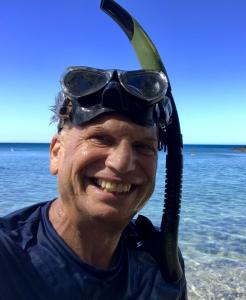UH Hilo’s Adam Pack awarded grant to study humpback whale mothers
University of Hawaiʻi at HiloInt Dir, Univ Rel; Dir, Media Rel, University Relations, Office of
A University of Hawaiʻi at Hilo professor specializing in humpback whale behavioral ecology and communication recently received a $5,000 grant from the National Marine Sanctuary Foundation to study stress in humpback whale mothers in the Hawaiian breeding grounds.
Dr. Adam Pack, professor of biology and psychology and founder of the UH Hilo Marine Mammal Laboratory (https://hilo.hawaii.edu/faculty/adam-a-pack/marine-mammal-lab/), is currently conducting research on “Assessing Stress in Humpback Whale Mothers Early and Late in the Breeding Season in Maui Waters by Comparing Blubber Cortisol and Corticosterone Concentrations to Body Condition Health Measures” through August 31, 2022. His grant will help support his collaborative work with the Marine Mammal Research Program of the Hawaiʻi Institute of Marine Biology, the Pacific Whale Foundation and University of Alaska Fairbanks to examine stress hormone concentrations in humpback whale mothers over their extended residency in Hawaiian waters during winter and spring months, which may last 50 or more days.
“The Hawaiian Islands are the principal mating and calving grounds for North Pacific humpback whales,” Pack said. “In Hawaiʻi, mothers fast and have to support their own energy needs as well as that of their nursing calves by relying on metabolized fat stores they have accumulated during summer months in Alaska while pregnant.
“My colleagues and I measure cortisol and corticosterone concentrations (two stress-related steroid hormones) in mothers with newly-born calves by extracting from them a tissue sample of blubber about the size of a pencil eraser using a sterile biopsy sampling technique. The biopsy sample can also be analyzed for progesterone concentration to reveal if a mother is also pregnant with her next calf. In conjunction with biopsy sampling, a drone is used to measure the mother's body condition -- as well as that of the calf -- and identification images are taken of the mother's tail flukes to match against archival catalogs to determine her minimum age and reproductive history,” he added.
The number of male escorts present with the mother-calf pair is also documented as Pack's earlier studies have shown that males seeking mating opportunities with mothers lead these females to expend more energy than if left alone with their calves.
“The findings from this study will help establish the natural stress response experienced by humpback whale mothers during the breeding season and allow researchers, the public and state and federal agencies charged with protecting humpback whales to better understand how natural stress variation may be compromised by anthropogenic stressors such as entanglement, vessel collisions, and underwater noise,” Pack explained.
Pack will present his research at the Hawaiian Islands Humpback Whale National Marine Sanctuary virtual research symposium November 4 & 5, 2021. The symposium, which is open to the public, will be held 8:30 a.m. to 11:30 a.m. HST to highlight research taking place in sanctuary waters.

